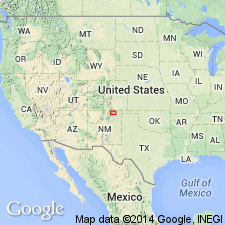
- Usage in publication:
-
- Chimney Divide coal bed*
- Modifications:
-
- First used
- Dominant lithology:
-
- Coal
- AAPG geologic province:
-
- Las Vegas-Raton basin
Summary:
First used; intent to name not stated, and no type locality designated. Also called Chimney Ridge. Is a coal bed near top of upper, coal-bearing division (of three divisions) of Raton Formation in central part of Raton coal field, Colfax Co, NM, Las Vegas-Raton basin; is highest coal bed in sequence. Crops out below crests of long, fingerlike ridges and underlies high drainage divides through an area of more than 50 sq mi. Commonly consists of two benches, each about 2 ft thick, separated by a carbonaceous shale parting 6 in to 1 ft thick. Outcrops usually obscured by brush, and bed is difficult to trace on surface. Coal bed may be made up of a series of lenses at approximately same stratigraphic position rather than of a single continuous bed. Extends northward to Canadian River, where coal becomes dirty and splits into several beds. This bed is most extensive commercial Raton Formation coal bed or composite zone in Raton field. Is about 1,880 ft above base of Raton Formation and about 2,200 ft above Upper Cretaceous Trinidad Sandstone in vicinity of York Canyon. Special circumstances of deposition control the accumulation of thick coal deposits; because these conditions are of a regional nature, occurrence of one thick coal at a particular stratigraphic position in one area should provide a clue to position of other similar deposits elsewhere in basin. Is of Paleocene age.
Source: GNU records (USGS DDS-6; Denver GNULEX).
For more information, please contact Nancy Stamm, Geologic Names Committee Secretary.
Asterisk (*) indicates published by U.S. Geological Survey authors.
"No current usage" (†) implies that a name has been abandoned or has fallen into disuse. Former usage and, if known, replacement name given in parentheses ( ).
Slash (/) indicates name conflicts with nomenclatural guidelines (CSN, 1933; ACSN, 1961, 1970; NACSN, 1983, 2005, 2021). May be explained within brackets ([ ]).

